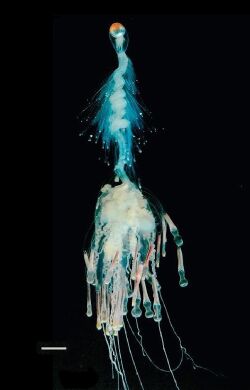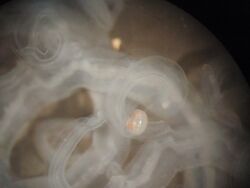Biology:Bathyphysa conifera
| Bathyphysa conifera | |
|---|---|

| |
| Scientific classification | |
| Domain: | Eukaryota |
| Kingdom: | Animalia |
| Phylum: | Cnidaria |
| Class: | Hydrozoa |
| Order: | Siphonophorae |
| Family: | Rhizophysidae |
| Genus: | Bathyphysa |
| Species: | B. conifera
|
| Binomial name | |
| Bathyphysa conifera | |
| Synonyms[4] | |
| |
Bathyphysa conifera, sometimes called the flying spaghetti monster, is a bathypelagic[4] species of siphonophore in the family Rhizophysidae.
Name
Bathyphysa conifera was nicknamed the Flying Spaghetti Monster, for the satirical deity of the Internet, by the oil workers who first saw it.[5] The specific epithet conifera, meaning 'cone-bearing',[6] is due to the shape of the cluster of reproductive structures called gonophores.[7] In Japanese it is called マガタマニラ[4][8] / まがたまにら / 勾玉韮[2] Script error: The function "transl" does not exist., "jewel leek". In Chinese it can be called 飞行的面条怪兽 Script error: The function "transl" does not exist. "flying noodles monster".[9]
Distribution
B. conifera has been found in the Northeast[10] and Northwest Atlantic Ocean,[11] off the coast of Gabon[12][13] and as far south as Angola,[14][15] and in Monterey Bay in the Pacific Ocean.[16][4]
Description
Although B. conifera may appear to be an individual organism, each specimen is in fact a colonial organism composed of medusoid and polypoid zooids that are morphologically and functionally specialized.[17] Zooids are multicellular units that develop from a single fertilized egg and combine to create functional colonies able to: reproduce, digest, float, and maintain body positioning.[18]
It has a cystonect body plan,[19] meaning it has a pneumatophore, or float, and siphosome, or line of polyps, but no nectosome, or propulsion medusae.[20] Without that propulsion, B. conifera moves through contracting and relaxing the body stem.[18] It differs from members of the genus Rhizophysa by the presence of ptera, or side 'wings', on the young gastrozooids, or feeding polyps.[21][14][15] It is distinct from other members of the genus Bathyphysa as its tentacles do not have any side branches, or tentilla.[19][21][14][15][18] Tentilla are thought to be ancestral to siphonophores, and B. conifera likely lost the trait as did Apolemia.[22][18] The tentacles have stinging cells called nematocysts that are haploneme, or uniform in thickness, and have a single size of isorhiza, or anchoring nematocysts.[22]
The entire animal, including tentacles, is several meters long.[15] The feeding polyps are pink when young, before developing tentacles.[15] A mature feeding polyp is yellow with a single tentacle.[15]
Colonies are unisexual,[15] and reproduce by incomplete asexual reproduction.[18] Not much more is known about B. conifera reproduction. Early development of cystonects is not known either.[23] Siphonophores generally start life as a single-celled zygote, which divided and grows into a single polyp called a protozooid.[23][18] The protozooid then divides by budding into all the zooids of the colony.[23] The zooids are homologous to individual animals, but are connected physiologically to each other.[18]
Ecology
Like many siphonophores,[17] it is carnivorous.[4][18] The typical siphonophore diet consists of a variety of copepods, small crustaceans, and small fish.[17] B. conifera has been observed eating a lanternfish.[16]
A species of manefish in the genus Caristius associates apparently mutualistically with B. conifera, using it for shelter, stealing meals, and perhaps nibbling on its host as well, yet protecting it from amphipod parasites like Themisto.[19]
References
- ↑ "Bathyphysa conifera" (in English). 2017. http://www.iucnredlist.org/search. "This taxon has not yet been assessed for the IUCN Red List, but is in the Catalogue of Life: Bathyphysa conifera (Studer, 1878)"
- ↑ 2.0 2.1 山田真弓. "マガタマニラ" (in Japanese). Asahi Shimbun Company / VOYAGE GROUP, Inc.. https://kotobank.jp/word/%E3%83%9E%E3%82%AC%E3%82%BF%E3%83%9E%E3%83%8B%E3%83%A9-1594768. "マガタマニラ まがたまにら / 勾玉韮 [学]Bathyphysa grimaldi"
- ↑ Prince of Monaco, Albert I; Guerne, Jules de; Richard, Jules (20 July 1904). "RHIZOPHYSALIÆ Bathyphysa grimaldii Bedot" (in French) (pdf). Résultats des Campagnes Scientifiques Accomplies Sur Son Yacht Par Albert Ier, Prince Souverain de Monaco 27 Siphonophores Provenant des Campagnes du Yacht Princesse-Alice (1892–1902): 16. doi:10.5962/bhl.title.2169. OCLC 14588383. https://www.biodiversitylibrary.org/page/2113994. Retrieved 5 September 2017.
- ↑ 4.0 4.1 4.2 4.3 4.4 Schuchert, P.; Mapstone, G. (2013). Bathyphysa conifera (Studer, 1878). In: Schuchert, P. (2017). World Hydrozoa database. Accessed through: World Register of Marine Species at http://www.marinespecies.org/aphia.php?p=taxdetails&id=135480 on 2017-09-01
- ↑ Feltman, Rachel (11 August 2015). "This deep sea creature looks just like the Flying Spaghetti Monster". The Washington Post. https://www.washingtonpost.com/news/speaking-of-science/wp/2015/08/11/this-deep-sea-creature-looks-just-like-the-flying-spaghetti-monster/.
- ↑ Griffith, Chuck (2005). "Dictionary of Botanical Epithets" (in English). http://www.winternet.com/~chuckg/dictionary/dictionary.66.html. "conifer conifera coniferum cone bearing conus con noun/m κωνοϛ cone i i cnct connective vowel used by botanical Latin fer fer apar fero to bear, carry, bring"
- ↑ Cite error: Invalid
<ref>tag; no text was provided for refs namedStuder - ↑ "Bathyphysa conifera – Biological Information System for Marine Life" (in English). Japan: Japan Agency for Marine-Earth Science and Technology. 2009. http://www.godac.jamstec.go.jp/bismal/e/view/9017123.
- ↑ 沈姝华 (2015-08-13). "Bathyphysa conifera". in 王晓易_NE0011 (in Chinese). http://news.163.com/15/0813/10/B0T4BRKI00014JB5.html.
- ↑ Costello, Mark J.; Emblow, Chris; White, Richard, eds (2001). "Ctenophora" (in English). European register of marine species : a check-list of the marine species in Europe and a bibliography of guides to their identification. Patrimoines Naturels. 50. Paris: Muséum national d'histoire naturelle. p. 122. ISBN 978-2-85653-538-7. "Order Cystonectae Family Physaliidae Family Rhizophysidae Bathyphysa conifera (Studer, 1878) A"
- ↑ Cairns, Stephen D.; Calder, Dale R.; Brinckmann-Voss, Anita; Castro, Clovis B.; Fautin, Daphne G.; Pugh, Philip R.; Mills, Claudia E.; Jaap, Walter C. et al. (2002) (in English). Common and Scientific Names of Aquatic Invertebrates from the United States and Canada: Cnidaria and Ctenophora. American Fisheries Society Special Publications. 28 (Second ed.). Bethesda, Maryland: American Fisheries Society. 29, 61. ISBN 978-1888569391.
- ↑ Leloup, Eugène (1955) (in fr). Expédition Océanographique Belge dans les Eaux Côtiëres Africaines de l'Atlantique Sud (1948-1949): Larve de cérianthaire - Siphonophores - Crustacés décapodes, Pagurides - Some Opisthobranchs from West Africa - Alcyonaires Atlantique intertropicaux III(4). 3. Bruxelles. p. 17. OCLC 247945591. http://www.vliz.be/imisdocs/publications/328138.pdf. Retrieved 19 March 2020.
- ↑ Capart, André (1951) (in fr). Expédition océanographique belge dans les eaux côtières africaines de l'Atlantique Sud (1948-1949): résultats scientifiques, 1(annex). 1. Bruxelles: Institut royal des Sciences naturelles de Belgique. p. 46. OCLC 769917737. http://www.vliz.be/imisdocs/publications/ocrd/236371.pdf.
- ↑ 14.0 14.1 14.2 Jones, Daniel O.B., Gates, A.R., Curry, R.A., Thomson, M., Pile, A., Benfield, M. (Eds) (2009). SERPENT project. Media database archive. Available online at http://archive.serpentproject.com/2621/ accessed on Fri Sep 01 2017
- ↑ 15.0 15.1 15.2 15.3 15.4 15.5 15.6 Jones, Daniel O. B.; Pugh, Philip R. (September 2018). "First sighting of a siphonophore of the genus Bathyphysa from the South Atlantic" (in en). Marine Biodiversity (Springer) 48 (3): 1279–1280. doi:10.1007/s12526-016-0611-1. ISSN 1867-1624. OCLC 6889763134.
- ↑ 16.0 16.1 "Bathyphysa conifera (Studer, 1878)" (in en). Monterey Bay Aquarium Research Institute (MBARI). http://dsg.mbari.org/dsg/view/concept/Bathyphysa%20conifera. Retrieved 19 March 2020.
- ↑ 17.0 17.1 17.2 Pacific, Aquarium of the. "Pelagic Siphonophore" (in en). http://www.aquariumofpacific.org/onlinelearningcenter/species/pelagic_siphonophore.
- ↑ 18.0 18.1 18.2 18.3 18.4 18.5 18.6 18.7 Munro, Catriona; Siebert, Stefan; Zapata, Felipe; Howison, Mark; Damian Serrano, Alejandro; Church, Samuel H.; Goetz, Freya E.; Pugh, Philip R.; Haddock, Steven H.D.; Dunn, Casey W. (2018-01-20). "Improved phylogenetic resolution within Siphonophora (Cnidaria) with implications for trait evolution". bioRxiv 10.1101/251116.
- ↑ 19.0 19.1 19.2 Janssen, John; Gibbs Jr., Robert H.; Pugh, Phil R. (27 February 1989). "Association of Caristius sp. (Pisces: Caristiidae) with a siphonophore, Bathyphysa conifera" (in English). Copeia 1989 (1): 198–201. doi:10.2307/1445624.
- ↑ Dunn, Casey. "Siphonophores: Body Plan". http://www.siphonophores.org/SiphPlan.php.
- ↑ 21.0 21.1 "'Flying Spaghetti Monster' Caught on Camera off Coast of Angola" (in English). Sci-News.com. 15 August 2015. http://www.sci-news.com/biology/science-bathyphysa-conifera-angola-03132.html.
- ↑ 22.0 22.1 Damian-Serrano, Alejandro; Haddock, Steven H.D.; Dunn, Casey W. (12 June 2019). "The Evolution of Siphonophore Tentilla as Specialized Tools for Prey Capture" (in en). bioRxiv: 653345. doi:10.1101/653345. https://www.biorxiv.org/content/10.1101/653345v1. Retrieved 19 March 2020.
- ↑ 23.0 23.1 23.2 Dunn, Casey. "Siphonophores - Life Cycle" (in en). http://www.siphonophores.org/SiphLifeCycle.php. Retrieved 29 March 2020.
External links
- Video footage
- Footage from Angolan waters
- Series of Sherman's Lagoon comic strips on the creature
- Caristius specimen found with a B. conifera
Wikidata ☰ Q2362673 entry


